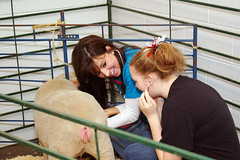Yesterday was Worldwide Pinhole Day, in case you didn't know. I went out to take some pinhole photos, did you? WWPD is the day you go out and take a photograph using the most primitive of gear - the pinhole camera. What's a pinhole camera, you ask?
It's a camera that uses a pinhole instead of a lens to transmit an image to the film plane. Because a pinhole is so small, it often takes much longer to take a photo - in my case the aperture is about ten stops past f/16. What that means is a pinhole image usually has some element of time lapse in it. The image also has infinite depth of field - an object 1 mm away will be rendered as clearly as one at the horizon.
One of the coolest things about pinhole photography, in my opinion, is making your own camera. I did this last year and it was a lot of fun, and a great learning experience. After many hours of work, I had finished Pharaoh, the Polaroid Pinhole camera. He accepts Polaroid packfilm, and is very wide angle, I'd estimate about 18 mm in 35mm terms. If you're not DIY-inclined, there are places to buy pinhole cameras and even a paper fold-up camera out there.
There's really not much more satisfying than taking a picture you love with a camera you built with your own hands. Try it out, it can be very addictive.
Pinhole Links...
f295 - A pinhole message board and community
Mr. Pinhole - Pinhole Camera building resource
Homemade Pinhole - Flickr group with photos of and from home-built pinhole cameras
Michigan Air Quality remains terrible
7 hours ago





